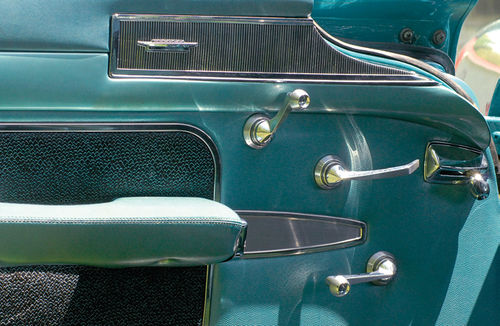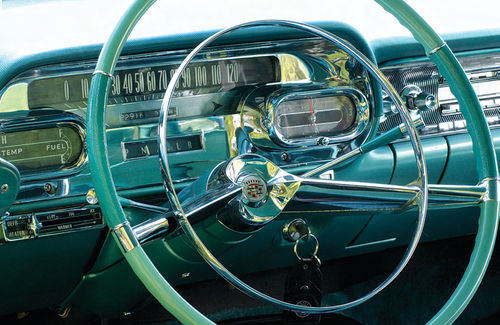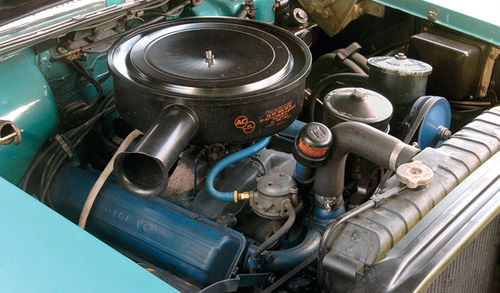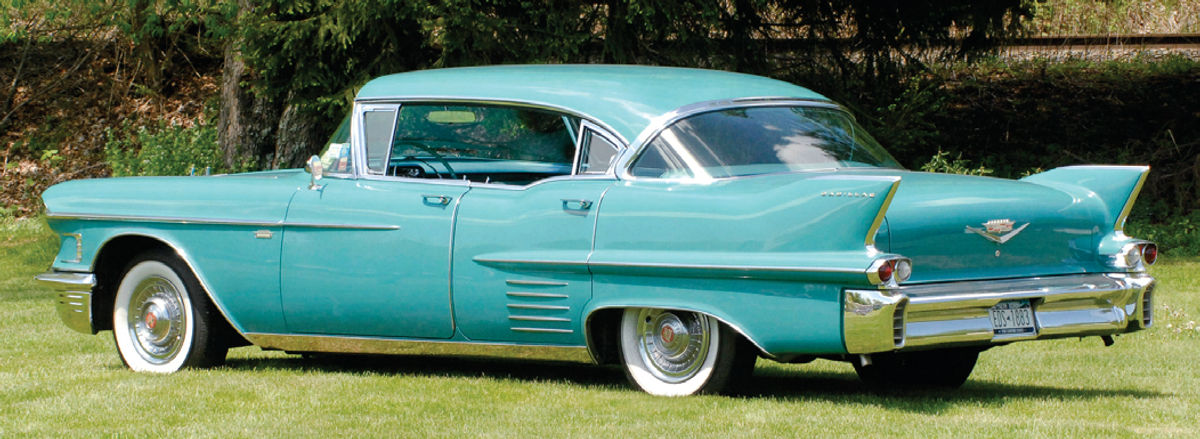1958 Cadillac Series 62
It Was After the Small-Finned Cars & Before the Big Fins of ’59. Sometimes, Being Different Says a Lot About a Car.
IT’S NOT EASY being caught between two worlds. Just ask the Cadillacs that bridged the gap between the first generation tailfin cars and their increasingly flamboyant descendants.
The task fell to the 1957 and ’58 models, which would break the tradition dating to 1948 that saw all but a few high end Cadillacs wear fins directly traceable to Harley Earl’s encounter with the Lockheed P-38 Lightning. Earl had quietly gotten a look at an early example of the twin-engine P-38 before Pearl Harbor and almost certainly must have recognized that its configuration was at once both radical and graceful. The P-38 stood out from most of its contemporaries among fighter aircraft because of its twin boom design; each of its engines was, in effect, in its own fuselage and the cockpit was centered on the wing that tied everything together. At the rear, a double tail similarly connected the two sides and gave Earl the approximate shape that would become the Cadillac tailfin.
The story of the Lightning’s influence on postwar Cadillacs via Harley Earl is well-known, but it’s often overlooked that there was a family connection, as well, thanks to the P-38’s engines. General Motors in 1929 had purchased Allison Engineering Company and under GM’s ownership as Allison Division, it developed the liquid-cooled V-1710 aircraft engine, two of which gave the P-38L variant a total of 3200 combat horsepower and a maximum speed of 390 miles per hour.
The Birth of the Cadillac Fin
Coincidentally, production of the V-1710 was winding down at about the same time that the 1948 Cadillac was introducing tail fins to the world.
With the sole exception of the long wheelbase Series 75 Fleetwood that would continue to use the prewar body through 1949, the 1948 Cadillac line represented a very large step ahead, but not at the expense of recognizable identity. A Cadillac remained obviously a Cadillac, but the new models were almost slab sided. Up front, the theme was based on the grille that had appeared in 1941 with its center bulge that followed the shape of the hood. The bars had evolved from being relatively fine and almost a mesh initially to broadly checked in 1947, but for 1948, they crossed the line to become the egg crate that was to be a signature Cadillac feature. The grille would go on for decades–an interpretation of it is on Cadillacs today–thus far exceeding the life span of the tailfin.
The original fin was nothing more than a very slight upward kick at the rear fender’s trailing edge to house the taillight. As such, it’s interesting, but whatever limelight it was accorded in 1948 was forgotten the following year thanks to a much more important innovation—Cadillac’s new V-8. Although it had built overhead valve V-12s and V-16s, all of the division’s V-8s through 1948 had been flatheads. That series ended on the introduction of 1949’s 160-horsepower, 331-cubic-inch OHV V-8, but the new engine’s significance went beyond its configuration.
The real key—the fact that everyone is referring to when calling the 1949 Cadillac engine a “modern” one—is that the new V-8 was an oversquare design. At 3.8125 inches, its bore is larger than its 3.625-inch stroke in a relationship that’s the opposite of the flathead’s 3.5-inch bore and 4.5-inch stroke. The oversquare OHV V-8’s reduced piston travel, easier cooling and other benefits spelled the end for most old-design engines. (Cadillac wasn’t alone in this step forward, as Oldsmobile introduced its equally modern OHV V-8 in 1949.)
That New, Eldorado Look
Like its engine, the Cadillac’s fins survived the substantial restyling that created the 1950 models. Although not quite as all-new as the 1948 cars had been from an appearance standpoint, the 1950 Cadillacs were undeniably attractive, somehow managing to combine a lower and less upright look with a slightly massive presence.
The new Cadillacs didn’t take up more space on the road than did other comparable cars, but they projected an importance and thus seemed like they might be bigger. The fins added to that impression by drawing attention to the rear, but with the car’s other styling cues, they were enough like those of the 1949 model to maintain continuity. It fit the car well overall and did so again when Cadillac introduced its next new body for 1954.
By then, the plump roundness of the earlier postwar years was on its way out among the automakers in general. Cadillacs were now smoother with flatter side panels, and a flatter roof and trunk lid as well. The lower deck lid helped the fins to stand out on the less rounded quarters and—on the two-door hardtops—a wraparound backlight completed the package. Hooded headlights, a finer eggcrate grille and a wraparound windshield graced the front view.
In 1955, things changed again.
Cadillac was then in its second year of using that body and with the exception of the Eldorado, its annual styling changes were mostly gentle updates that didn’t impact on the car’s character.
The Eldorado, though, was freshened in a way that was anything but gentle. The wheel well was unskirted and thus showed more of the wheel and tire than did other 1955 Cadillacs and that alone set the Eldorado apart, but the unique fin was actually much more important in that it eliminated Harley Earl’s P-38 derivative for the first time since 1948. The Eldorado substituted a flat, blade-like fin that was more angular, leaned rearward at the top and wore its taillight not rising from the upper rear edge as on lesser Cadillacs, but just above the bumper in a round pod on the outside of the fin. The taillight was mirrored on the inside by an identically mounted backup light.


In effect, the 1955 Eldorado was offering the public a glance at some of Cadillac’s plans for the not-too-distant future.
After another freshening of the 1954 body to create the 1956 Cadillac, the division took a very different approach for its 1957 models by applying some of the details that it had tested on the 1955-56 Eldorado. The most obvious was a scaled-back version of the fin and a similar taillight arrangement, but one relatively small detail wasn’t carried over from the Eldorado or other 1956 Cadillacs. What had been a vertical A-pillar now swept rearward at the base and with the vent window repeating the angle, the car seemed to be leaning into the wind. Adding a flatter hood helped to produce a more modern feeling, as did lengthening body-side stampings at front and rear.
If the previous car had been attractive, the 1957 Cadillac was equally so in a new way. The older model’s overall dignity had mostly been replaced with a hard-to define look of late-1950s flash that appealed to some and turned off others, but despite a drop in sales—from 154,577 in 1956 to 146,841 in 1957— the division built on it for 1958. Up front, dual headlights appeared, the bumperettes were simplified and while the egg crate pattern was still there, it was hidden behind small round ornaments at every intersection.
And then there were the fins. What might’ve been described in 1957 as having been influenced by the previous Eldorado was now much closer to that car’s look. Still just as angular, but lifted to the approximate altitude and shape of the Eldorado’s, the 1958 fins were an excellent fit to the rest of the car. Just in case anyone missed that, though, Cadillac offered a second version of the sedan in the Series 62 line that added 8.5 inches to the length of the deck.
1958 Cadillac Series 62
GENERAL
Front-engine, rear-drive, four-door hardtop
ENGINE
Type Overhead-valve V-8
Displacement 365 cu. in.
Bore x stroke 4.00 in. x 3.625 in.
Compression ratio (:1) 10
Carburetor Four-barrel downdraft
Power 310 hp @ 4800 rpm
Torque 405 lb.-ft. @ 3100 rpm
DRIVETRAIN
Transmission Four-speed Hydra-Matic
Final drive ratio (:1) 3.07
SUSPENSION & BRAKES
Front Independent, coil springs
Rear Live axle, coil springs
Brakes (f/r) Drums, power-assisted
STEERING
Recirculating ball, power-assisted
MEASUREMENTS
Wheelbase 129.5 in.
Length 216.8 in.
Height 59.1 in.
Width 80 in.
Track (f/r) 61/61 in.
Weight 4675 lb.
Tire size 8.00 x 15
It was “a new American classic,” according to an introductory ad. “Certainly, one glance at its extraordinary grace and symmetry will tell you instantly that this is motordom masterpiece in styling. Its new sweep and stature, its remarkable new rear fender design, its dazzling new grille and four-headlamp system, and its tasteful use of chrome and color…all mark it as a singularly beautiful and majestic automotive creation.”
Ask the Man Who’s Owned Several
For Bob Wells of Unadilla, New York, the promise in that advertising wasn’t the selling point for his 1958 Series 62 four door hardtop. Instead, his decision to buy was the result of experience.
“I had ’57s and ’67s,” Wells said. “I had three ’62s, I had ’65s. I had them all. I always drove Cadillacs.”
He’d been looking for a 1967 convertible in the spring of 2008 and when he spotted an ad for the feature car, decided that it was worth investigating. The odometer showed 21,000 miles and the few problems that the car had were anything but major.
“I wanted a better paint job on it,” Wells recalled. “The original was polished down. The paint was still there, but if you tried to buff it out, you’d lose it. (There were) no dings, no rust, nothing. The chrome is excellent on it. It looks like it was just put on there, but it hasn’t been.”
The condition of the original paint was actually the biggest of the problems, even if correcting it required no bodywork beyond stripping and repainting. Another was in the Autronic Eye, the electronic sensor that flips the headlights between high- and low-beam automatically as it reads oncoming traffic.
The unit worked when Wells bought the car, but he said that the seller had told him that he had disabled it because it was malfunctioning.
“He said ‘it goes up and down too much,’” Wells recalled, “but he didn’t know how to adjust it. You can adjust it on a box under (the hood) or on the foot pedal, the dimmer.”
The Cadillac isn’t a transportation car that’s frequently driven at night and the Autronic Eye’s problem doesn’t keep the headlights from operating conventionally, so Wells hasn’t yet corrected it. He’s owned other Cadillacs equipped with the feature and said that it’s generally a reliable component.
“They work fine,” he said. “It just needs to be tuned.”
An Autronic Eye that was out of adjustment had nothing to do with how well the Cadillac performed when he bought it in State College, Pennsylvania, of course. Wells said that he and his son drove it home uneventfully in a roughly four-hour trip. Uneventfully, though, doesn’t mean the drive was boring.
“I drove it until we got out of town,” Wells recalled. “I had a heck of a time driving it that far because it had the bias tires on it. I forgot all about those things and as old as I am, I should’ve remembered.”
Radials have since eliminated that difficulty and the car continues to run well today, but then these Cadillacs’ drivetrains are generally trouble-free if they’re given normal maintenance.
“They all run fine,” Wells said. “You never have any problems that way.”
If You’re In the Market…
That’s not an invitation to ignore a car’s mechanical condition, but Wells said that if he were considering another one, he’d focus on the body for two distinct reasons. The obvious one is rust and these cars are susceptible in the areas typical of General Motors’ cars of the day. That means they need to be inspected carefully around the headlights, the heels of the fenders, the rocker panels, the quarter panels and the frame above the rear axle.
Wells was lucky; when the feature car was painted, its fenders and all of its trim were removed to reveal that it had no hidden rust. He was lucky, too, in another potential rust-area that might be overlooked by someone unfamiliar with these cars, the rear bumper ends. The problem there is that the factory exhaust exits through an opening in each end and hastens its deterioration. Despite the feature car’s low mileage, a previous owner changed the tailpipes to route them out below the bumper.
“There’s a hole for it,” Wells said, “but I don’t want it to come out there, either.”
Not all 1958 Cadillacs have survived so well, but he emphasized that even one with virtually no rust might not automatically be the car to buy. One potential red flag is the optional air suspension, a complex system that worked well in 1958, but was by no means bulletproof. A car so equipped can be converted to a conventional suspension, if necessary, but it’s something to think about when making the decision.
Another consideration is that replacing a missing or defective accessory can be difficult and costly.
“And if you find one that’s got a nice body and the chrome’s all (bad),” Wells said, “you might better leave it sitting right there. The chrome will cost you more than you’ll pay for the car… The sides are stainless. The rest is all chrome.”
Even allowing for the emblems and block lettering that aren’t plated, there’s still a lot and it will be expensive.
One experience that supports Wells’ position has to do with the dashboard mounted map light. Its switch had failed and he found one in a salvage yard car not far from his home. When he couldn’t get into the car to remove it, he resumed the search and found another in Texas. The price was too high and he hasn’t found a third, so the map light still doesn’t work. Wells believes that the switch was damaged by improper rewiring after the rheostat in the headlight switch failed. He’s in the process of correcting that by replacing the headlight switch.
“I ordered one and I got it,” he said. “It’s the whole switch. You’ve got to get the one with the fog lights on it and that’s what I got.”
Fog lights were more of a rarity in 1958 than they are today and bordered on the exotic, but they fit well with the rest of the Cadillac’s personality.
It’s not an in-your-face attitude; it’s more one of having made it and being unashamed to say so. Cadillac cited that very approach when its advertising stated: “What a priceless satisfaction it is to ride—here where the world’s leading citizens ride—and catch the admiring glances of your fellow motorists.”
Capable of Drawing a Crowd
The feature car hasn’t lost that touch and remains entirely capable of drawing attention itself.
“They run out of the woodwork when they see it,” Wells said. “The older people (recognize it). The younger ones don’t know what the heck it is, only that it’s big. They want to know what it is. If you leave it there alone, everybody’s walking around it and looking at it.”
Other motorists notice it, too, something I confirmed while driving the Cadillac around the Unadilla area on a weekday afternoon.
Heads turned and there were waves and that universal signal of approval for vintage cars, the thumbs-up, but Wells was right; they really do run out of the woodwork. Several small groups of pedestrians either pointed to us as we passed by or just stared. Just as Cadillac intended, this is not a car that blends into the background.
On the other hand, Cadillac also stated that “within the first few miles, you will know that this is, beyond any question, automotive performance at its masterful best!” Maybe that’s a bit extreme, but there’s an awful lot that’s right about the feature car. It’s fast, with 50 miles per hour requiring very little pedal, and while the brakes feel nothing like those of a modern Cadillac, they work well. I already knew that because I’ve driven other Cadillacs like it, but I was reminded when I was a little late in seeing the left turn that I wanted. The brakes and the suspension did their job and the car was easily controlled, but I suspect that it would’ve been more spectacular on bias-ply tires than on the radials…far more spectacular.

Caught In the Middle With You
Besides the Cadillac’s comfort level and overall quiet—the turn signal’s clicking and the transmission’s shifting are about the only sounds—there’s also the odd contradiction between its handling and its size. It doesn’t drive like a 2009 Cadillac drives yet it doesn’t drive the way its size suggests it should drive. While it’s impossible to forget that it’s big, the car doesn’t wallow. A driver who somehow does manage to forget its size will remember every time he looks in the side mirror and sees that fin at the other end.
The 1957-58 fin lasted just two years, although counting the limited-production Eldorado that introduced it doubles that figure. It’s hard to say whether it paved the way for the extravagance of the 1959 Cadillac, and whether any car could’ve done that is a valid question. Some see the 1959 design as wonderfully exuberant and others consider it appallingly freakish, but from the day it was introduced, it’s been memorable. Seemingly everyone recognizes the 1959 Cadillac and to many, the 1953 through 1956 production models are among the division’s highlights…but those from the years between are often overlooked. That’s neither completely fair nor especially wise.
“A Cadillac is a Cadillac in every detail,” the division advertised, “the Standard of the World in all the things that make a motorcar good and fine and desirable.”
Yes, it was copywriting, but it also happened to be true.

















